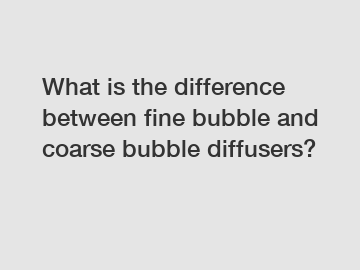What is the difference between fine bubble and coarse bubble diffusers?
Fine Bubble Diffusers vs. Coarse Bubble Diffusers: Understanding the Differences.
When it comes to wastewater treatment systems, diffusers play a crucial role in aerating the water and promoting the growth of beneficial bacteria. Two common types of diffusers used in these systems are fine bubble diffusers and coarse bubble diffusers. While both serve the same purpose, they have distinct differences in terms of their design, efficiency, and performance. In this article, we will explore the variances between fine bubble and coarse bubble diffusers to help you understand which one may be more suitable for your wastewater treatment system.
Fine Bubble Diffusers.

Fine bubble diffusers are designed to produce small bubbles, typically less than 2mm in diameter, which stay suspended in the water column for an extended period. These diffusers are usually made of materials such as EPDM, silicone, or polyurethane, which are known for their durability and flexibility. Fine bubble diffusers are highly efficient in transferring oxygen to the water and provide a large surface area for the exchange of gases.
One of the key advantages of fine bubble diffusers is their high oxygen transfer efficiency, which helps in promoting the growth of aerobic bacteria that break down organic matter in the water. Additionally, these diffusers operate quietly and produce a steady stream of bubbles, creating a uniform distribution of oxygen throughout the water column. Fine bubble diffusers are ideal for applications where a high level of oxygen is required, such as in activated sludge systems and nutrient removal processes.
Coarse Bubble Diffusers.
In contrast, coarse bubble diffusers produce larger bubbles, typically between 2mm and 50mm in diameter, which rise quickly to the surface of the water. These diffusers are typically made of materials such as PVC or stainless steel and are designed for applications where a higher flow rate of air is required. Coarse bubble diffusers are known for their robust construction and resistance to clogging from debris or solids in the water.
While coarse bubble diffusers are not as efficient in transferring oxygen to the water as fine bubble diffusers, they are often used in applications where mixing and circulation of water are more critical than oxygen transfer. Coarse bubble diffusers are commonly found in industrial wastewater treatment plants, lagoons, and aerated ponds where the removal of solids and maintenance of a homogenous environment are essential.
Differences in Performance.
The primary difference between fine bubble and coarse bubble diffusers lies in their performance characteristics. Fine bubble diffusers are more efficient in transferring oxygen to the water due to their smaller bubble size and larger surface area. On the other hand, coarse bubble diffusers are better suited for applications that require higher flow rates of air and enhanced mixing capabilities.
Another difference between the two types of diffusers is their resistance to fouling. Fine bubble diffusers are more prone to fouling from biological growth and solids buildup, which can reduce their effectiveness over time. In contrast, coarse bubble diffusers are less susceptible to fouling and can handle higher levels of debris in the water without clogging.
Conclusion.
In conclusion, the choice between fine bubble and coarse bubble diffusers depends on the specific requirements of your wastewater treatment system. Fine bubble diffusers are ideal for applications that require high oxygen transfer efficiency, while coarse bubble diffusers are better suited for applications that prioritize mixing and circulation of water. By understanding the differences between these two types of diffusers, you can make an informed decision that maximizes the performance of your wastewater treatment system.
Contact Us.
If you have any questions or require further assistance in selecting the right diffusers for your wastewater treatment system, please do not hesitate to contact us. Our team of experts is dedicated to helping you find the best solution for your specific needs.
If you are looking for more details, kindly visit smc panel water storage tank, metal water tank, louver cooling tower.
192
0
0


Comments
All Comments (0)